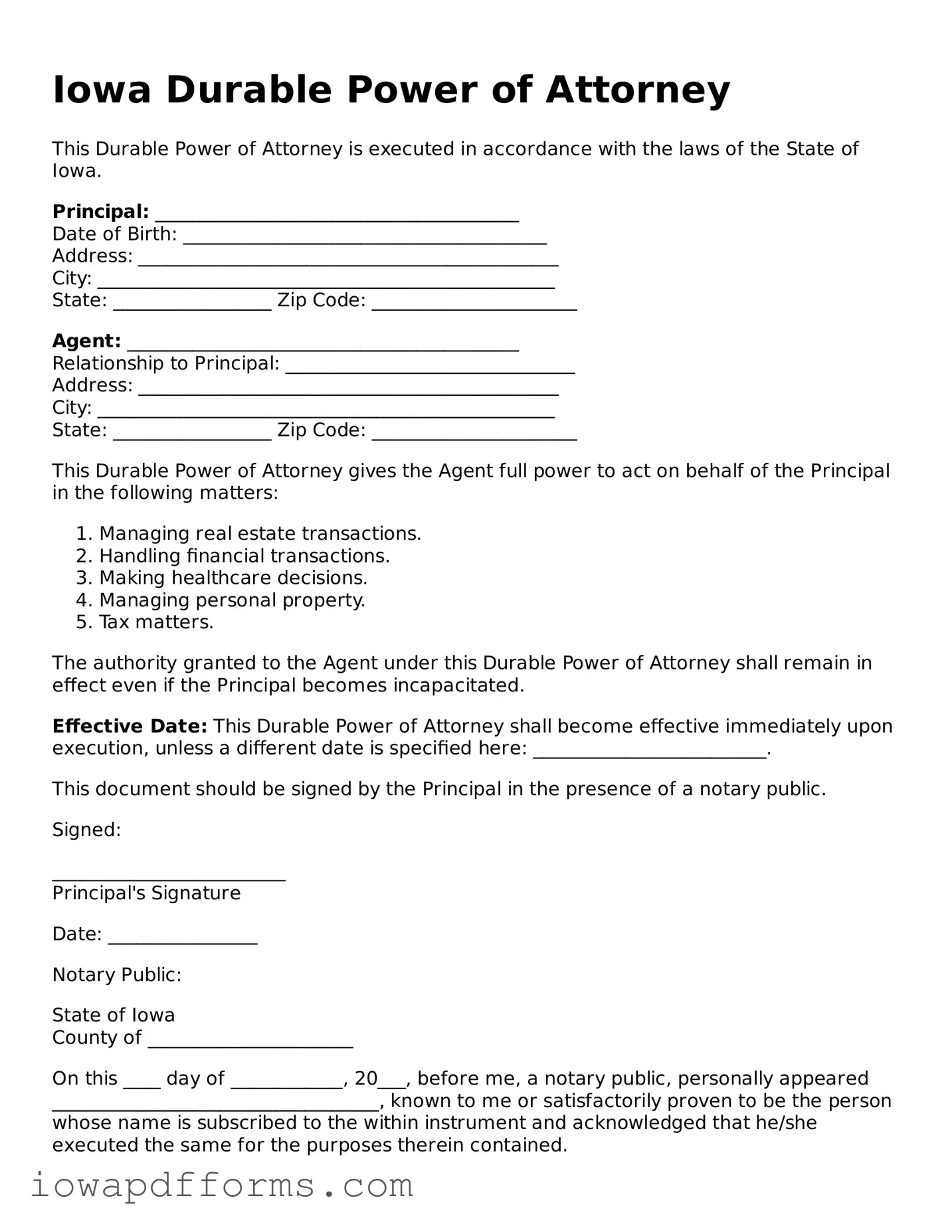The Iowa Durable Power of Attorney (DPOA) form shares similarities with the General Power of Attorney. Both documents allow an individual to appoint someone else to make decisions on their behalf. The key difference lies in the durability aspect; the DPOA remains effective even if the principal becomes incapacitated, while the General Power of Attorney may become invalid under such circumstances.
Another document that resembles the DPOA is the Medical Power of Attorney. This form specifically grants authority to a designated person to make healthcare decisions for the principal when they are unable to do so. While the DPOA can cover financial matters, the Medical Power of Attorney focuses solely on health-related decisions, ensuring that medical preferences are respected.
The Living Will is another document that aligns with the DPOA in terms of end-of-life decisions. A Living Will outlines a person's wishes regarding medical treatment in situations where they cannot communicate their preferences. While the DPOA designates someone to make decisions, the Living Will provides specific instructions, making them complementary in managing a person's healthcare and financial matters.
A Trust Agreement shares similarities with the DPOA by allowing an individual to designate a trustee to manage their assets. Both documents facilitate the management of financial affairs, but a Trust Agreement often provides more detailed instructions regarding asset distribution. In contrast, the DPOA grants broader authority to the agent, covering various financial decisions without the same level of specificity.
The Advance Directive is another document that parallels the DPOA. It combines elements of both the Medical Power of Attorney and the Living Will. An Advance Directive allows individuals to express their healthcare preferences and appoint someone to make decisions on their behalf. Like the DPOA, it ensures that a person's wishes are honored, particularly during critical health situations.
The Healthcare Proxy is similar to the Medical Power of Attorney in that it designates someone to make healthcare decisions. While both documents serve the same purpose, the Healthcare Proxy is often used in specific states and may have different requirements. The DPOA can include health-related decisions as well, making it a more comprehensive option for managing both financial and medical affairs.
The Financial Power of Attorney is closely related to the DPOA, as both authorize someone to handle financial matters on behalf of the principal. The primary distinction is that the Financial Power of Attorney may not necessarily be durable, meaning it could become invalid if the principal loses capacity. In contrast, the DPOA remains effective under those circumstances, providing continuous support in managing financial responsibilities.
The Authorization for Release of Information is another document that shares some similarities with the DPOA. This form allows an individual to grant permission for someone else to access their personal information, often for medical or financial purposes. While the DPOA empowers an agent to make decisions, the Authorization for Release of Information is more about sharing specific data, making it a useful complement to the DPOA.
When considering renting a property, it's essential for potential tenants to complete a Rental Application form, which serves as a crucial step in the leasing process. This form enables landlords to collect pertinent information about applicants, including personal, employment, and financial details, thereby assisting in the selection of suitable tenants for their properties.
The Guardianship Petition is also related to the DPOA in that both address the need for decision-making support. However, a Guardianship Petition is a legal process that appoints a guardian for someone who is unable to make decisions due to incapacity. In contrast, the DPOA is a proactive measure that allows individuals to choose their own agent before incapacity occurs, providing more control over future decisions.
Lastly, the Bill of Rights for Residents of Long-Term Care Facilities can be seen as similar in purpose to the DPOA, as it ensures that individuals have certain rights regarding their care and treatment. While the DPOA focuses on appointing someone to make decisions, the Bill of Rights emphasizes the individual's autonomy and dignity in a long-term care setting. Both documents ultimately aim to protect individuals' interests, albeit in different contexts.
